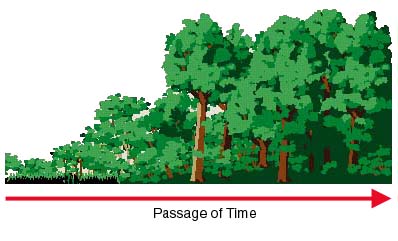Ecological Succession
The classical ecological definition of plant succession involves a predictable set of vegetative changes through a series of discrete stages (seres). Recent challenges to the original succession concept suggest that succession does not necessarily involve a "climax" stage (after which additional changes in dominant species and structure do not normally occur). Within the watershed, succession may vary with spatial scale, elevation, and topography. Modern successional theories view the landscape as being in a sort of dynamic equilibrium, in that various patches make up a shifting mosaic of various successional stages.
In watershed terms, succession is a process that circulates significant amounts of the watershed's energy, water and materials from the abiotic environment back into the biotic, and from one set of predominant organisms on to a subsequent set of dominant organisms. Characteristic forms of succession may be typical of specific parts of the watershed (see examples below). Succession builds and gradually changes vegetational structure that serves many critical functions such as maintaining varied habitat (recall the earlier discussion of the highest biodiversity often being found in areas of intermediate disturbance) and reestablishing renewable resources for human use, like woodlots.
![[logo] US EPA](https://www.epa.gov/epafiles/images/logo_epaseal.gif)
